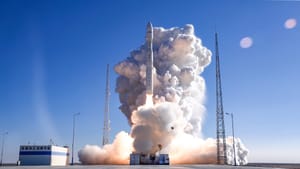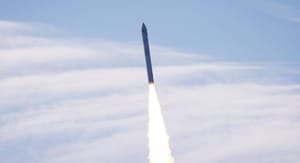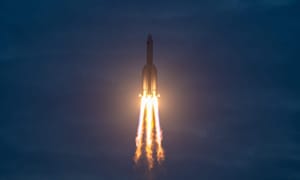
Early on the 23rd of January, CAS Space launched its first mission of the year carrying five satellites atop of its Kinetica-1 rocket. The Kinetica-1 rocket lifted off from Launch Area 130 at the Jiuquan Satellite Launch Center and flew to a sun-synchronous orbit of the Earth.
The five satellites onboard were spatial observation spacecraft manufactured by the Chinese company MINOSPACE. The satellites were; Taijing-1 03, Taijing-2 02 & 04, Taijing-3 02, and Taijing-4 03.
MINOSPACE, the primary customer of this mission for Kinetica-1, is a Chinese satellite R&D and manufacturing company. The company manufactures satellite platforms, commonly called a 'bus', along with entire satellites. They also offer manufacturing services for components such as; electronic communications, internal systems, and optical payloads.
This was the third successful launch of the Kinetica-1 rocket, so far the Kinetica-1 has not failed during a mission.

The first stage booster of Kinetica-1 for this launch also had a traditional Chinese Loong, commonly called a Dragon in the Western world, painted on the first stage of the rocket. The logo was designed by the Chinese Ministry of Culture and Tourism. It is believed the Loong was painted on the side to celebrate the upcoming Chinese New Year, which is on the 10th of February.

In a believed partnership with the Chinese food brand Master Kong, CAS Space attached a pot of instant noodles to the payload adapter of Kinetica-1 for its third mission. The launch of the noodles is believed to be celebrating the support given by Master Kong to China's aerospace industry. In materials made by Master Kong the noodles attached to Kinetica-1 are reportedly 'aerospace-quality Chinese noodles'.
What is Kinetica-1?
Kinetica-1 is a four-stage launch vehicle that burns solid fuel in all of its stages. Kinetica-1 is currently manufactured and operated by launch provider CAS Space, or Chinese Academy of Sciences Space.
The Kinetica-1 launch vehicle can carry up to 2,000 kilograms to low Earth orbit or 1,500 kilograms to a 500-kilometer sun-synchronous orbit. CAS Space offers the ability to launch a single satellite to utilize all of the rocket's payload capacity but commonly flies 'rideshare' missions for multiple satellites.

So far the Kinetica-1 has been launched from the Jiuquan Satellite Launch Center, in Northern China, but CAS Space has expressed interest in launching from a sea launch platform, likely from the Haiyang sea launch spaceport similarly to OrienSpace and Galactic Energy.
The first-stage of Kinetica-1 is powered by a solid rocket booster burning an unspecified solid propellant to generate 200 tons of thrust. CAS Space is yet to disclose the burn time of the booster.
The second-stage is powered by another solid rocket booster burning the same unspecified solid propellant to generate 110 tons of thrust. The burn time of the booster is unknown to the wider world.
The third-stage is powered by a solid rocket booster burning the same unspecified solid propellant again to generate 45 tons of thrust. The burn time of the stage is currently unknown to the wider world.
The fourth-stage is powered by a solid rocket booster again burning the same unspecified solid propellant to generate 8 tons of thrust. The burn time of this stage is currently unknown.
Kinetica-1 weighs 135,000 kilograms when on its launch pad. The rocket is 30 meters tall with the fairing being 2.65 meters in diameter.
Inferring from information on CAS Space's website, the Kinetica-1 rocket has a cost per kilogram of approximately 8460 United States Dollars with a launch cost of approximately 17 million United States Dollars. CAS Space may however be charging its customers less to compete with other launch providers. (This cost information is using the exchange rate between the Chinese Yuan Renminbi and United States Dollars on the 23rd of January 2024.)
Who is CAS Space?
CAS Space, or Chinese Academy of Sciences Space, is a Chinese launch provider partially owned by the Chinese Academy of Sciences. The company was founded in 2018 in Beijing but is currently headquartered in Guangzhou.
As of January 2024, the company has successfully launched thirty-seven satellites into orbit over three launches with no failures.




